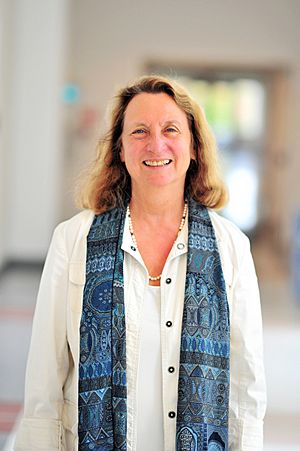Elaine Oran facts for kids
Quick facts for kids
Elaine Surick Oran
|
|
|---|---|

Oran in 2013
|
|
| Born | April 16, 1946 Rome, Georgia, U.S.
|
| Alma mater | Bryn Mawr College Yale University |
| Spouse(s) | Daniel Oran |
| Awards | Fluid Dynamics Prize (APS), 2013 |
| Scientific career | |
| Fields | Computational physics, Explosions, Propulsion, Turbulence, Astrophysics |
| Institutions | Texas A&M University University of Maryland, College Park U.S. Naval Research Laboratory |
Elaine Surick Oran (born April 16, 1946) is an American scientist. She is known for using computers to understand how things work in the real world. She created special computer tools to solve tricky problems about how things flow and react. Her work brings together ideas from science, math, engineering, and computers.
Her methods help us understand many different things. This includes how fish swim together in the ocean. It also covers giant explosions in space called supernovae. Her work has greatly helped the field of engineering.
Contents
Elaine Oran's Education
Elaine Surick went to school in Philadelphia, Pennsylvania. She earned a bachelor's degree in physics and chemistry from Bryn Mawr College in 1966. She then studied at Yale University. There, she received a master's degree in physics in 1968. She also earned a Ph.D. in engineering and applied sciences in 1972.
Elaine Oran started working at the United States Naval Research Laboratory (NRL) in 1972. She joined a science division there. In 1978, she moved to a lab focused on computer physics. She helped start a center to study how things flow and react. She later became the head of this center. By 1988, she was a top scientist studying how things flow and react.
She has done important research using computers. This research helps us understand how fluids and molecules behave in complex systems. Her team has created many computer models. These models accurately show how reactive flows work.
Reactive flows happen when gases, liquids, or solids move and change chemically. These problems often involve many things happening at once. Understanding where these reactions start and how they interact is key. Elaine Oran's work helps scientists study many things. This includes how fire spreads in cities or forests. It also helps with how car engines work. Her work can even be used to study stars and how the universe formed.
At the Naval Research Lab, Oran used her methods for many projects. She helped design biosensors. She also worked on propulsion systems for rockets and jets. Her research supported the safe storage of hydrogen fuels.
Aerospace Engineering Work
Elaine Oran is currently a professor at Texas A&M University. From 2013 to 2019, she was a professor at the University of Maryland in the aerospace engineering department. She is still an emeritus scientist at the U.S. Naval Research Laboratory. She also teaches at the University of Michigan and Leeds University. She is a visiting professor at other universities too.
Awards and Honors
Elaine Oran has received many awards. She is an Honorary Fellow of the American Institute of Aeronautics and Astronautics (AIAA). This is the highest award from AIAA. It is given to people who have done great work in aerospace. She is also a Fellow of the American Academy of Arts and Sciences. She is a member of the National Academy of Engineering.
Awards
- Hoyt C. Hottel Keynote lecture at the International Combustion Symposium, 2014
- Fluid Dynamics Prize (APS), 2013, from the American Physical Society (APS)
- Presidential Rank Award for Distinguished Senior Professionals, 2007
- Society of Women Engineers Achievement Award, 2006
- Dryden Lectureship in Research Award from American Institute of Aeronautics and Astronautics, 2002
- Women in Technology International (WITI) Hall of Fame, 2002
- Combustion Institute's Zeldovich Gold Medal, 2000, for "outstanding contributions to the theory of combustion and detonations."
- Oppenheim Prize, 1999, for "outstanding contributions to the theory of the dynamics of explosions and reactive systems."
- Arthur S. Flemming Award, 1979
Honorary Degrees
- Doctor of Science, honoris causa (DSc) from the University of Leeds, 2010
- Docteur Honoris Causa from the École Centrale de Lyon, 2006
- Docteur Honoris Causa, Institut National des Sciences Appliquées Rouen, 2015
Memberships
- Elected an international fellow of the Royal Academy of Engineering, 2024
- Fellow, American Academy of Arts and Sciences, 2018
- Fellow, The Combustion Institute, 2018
- Member, Committee on Human Rights, National Academies of Science, Engineering and Medicine
- Fellow of the American Society of Mechanical Engineers (ASME), 2012
- Advisory Board, Acta Mechanica Sinica, 2011–Present
- Honorary Fellow of the American Institute of Aeronautics and Astronautics (AIAA), 2011
- Fellow of the Society for Industrial and Applied Mathematics (SIAM), 2009
- Member of the National Academy of Engineering, 2003
- Fellowship in the American Physical Society (APS), 1993
- Fellow of the American Institute of Aeronautics and Astronautics (AIAA), 1990
- Society of Women Engineers

